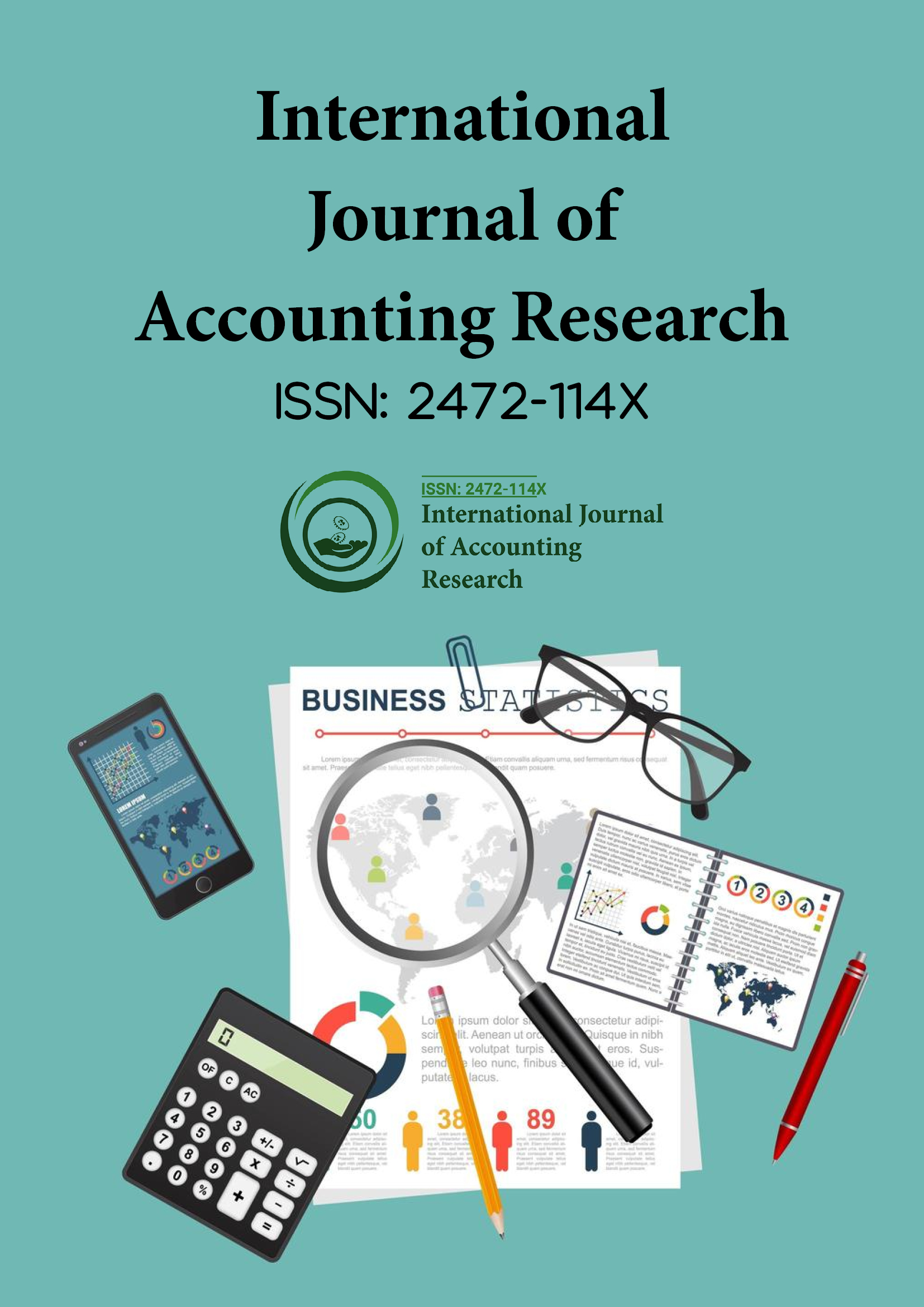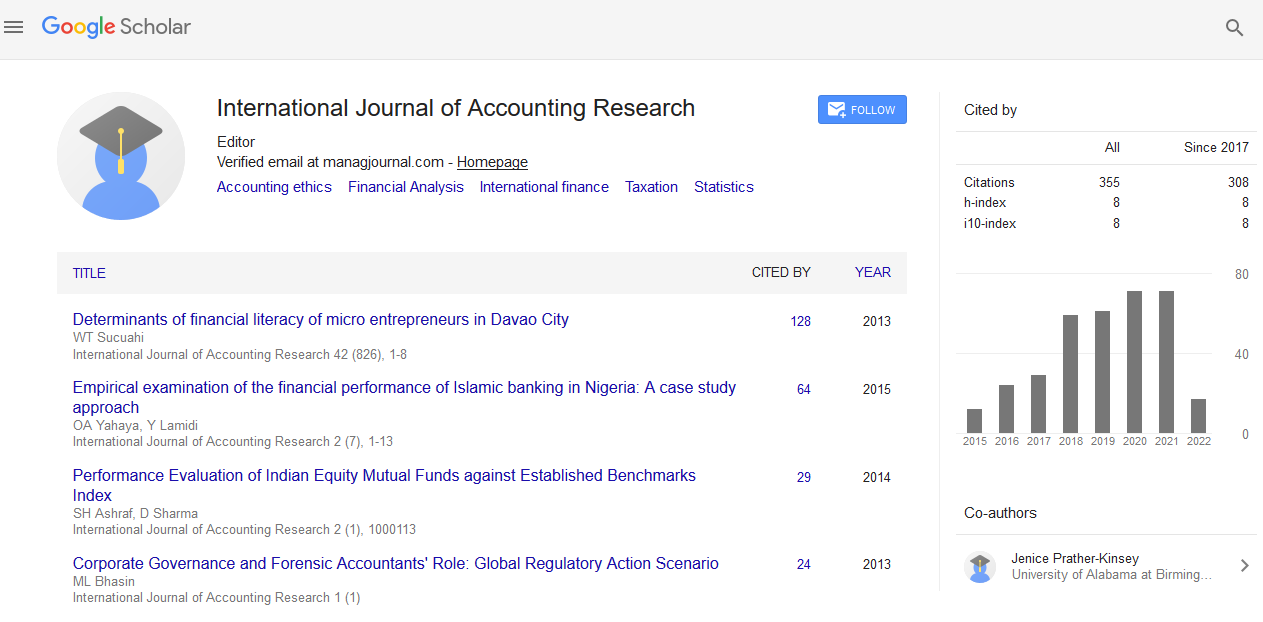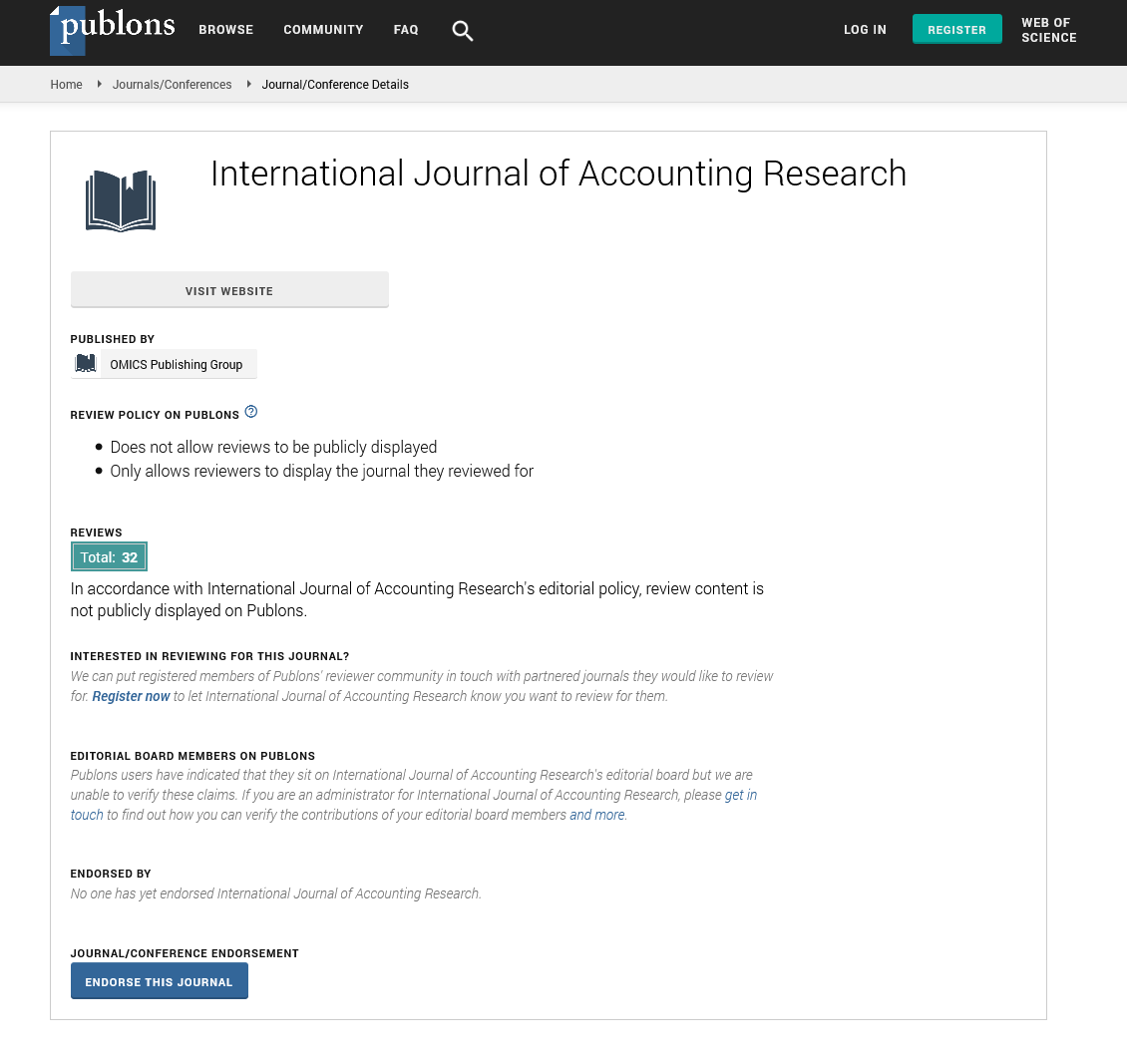Indexed In
- Open J Gate
- RefSeek
- Hamdard University
- EBSCO A-Z
- Scholarsteer
- Publons
- Euro Pub
- Google Scholar
Useful Links
Share This Page
Journal Flyer

Open Access Journals
- Agri and Aquaculture
- Biochemistry
- Bioinformatics & Systems Biology
- Business & Management
- Chemistry
- Clinical Sciences
- Engineering
- Food & Nutrition
- General Science
- Genetics & Molecular Biology
- Immunology & Microbiology
- Medical Sciences
- Neuroscience & Psychology
- Nursing & Health Care
- Pharmaceutical Sciences
Editorial - (2021) Volume 9, Issue 12
Cost Account : Coffers, Benefits, Downsides
Kidabe*Received: 30-Nov-2021 Published: 14-Dec-2021
Costs can be accrued grounded on the budget of directors, governments or other realities. For illustration, values of yield losses or fresh control costs are frequently included when the cost account approach is applied to capture the impacts of an irruption on an agrarian patron budget. Also, costs of forestalment, surveillance, and exploration programs are bring particulars included when assessing impacts on governmental budgets. Disentangling charges incurred by importing vs. exporting countries is pivotal when assessing pre border costs. Results from cost account can be expressed at the individual patron position or at the indigenous/ public position by aggregating the costs across all directors. It's possible to epitomize costs accrued over time by blinking all unborn costs to the present value. In general, the cost account approach assumes that (1) commodity prices are constant (i.e., asleep to changes in force), and (2) there's no change in the blend of products consumed due to invasive species or forestalment measures. Cost account estimates also serve as demanded input parameters for estimating species impact and forestalment costs using other approaches described below.
Coffers demanded to use cost account
Estimating direct account cost is fairly straightforward and generally uses being data that are constantly recorded by government departments (e.g., biosecurity budget reports), primary directors or other realities. Being literature may also be used to condense data and more inform estimates. Operation of a cost account approach requires information regarding what fresh costs will be incurred (e.g., pest damages, control costs, forestalment costs), what costs will be reduced (e.g., eased damages, excluded unborn control costs via eradication), and how returns will be impacted (e.g., reduced labors). The added costs and reduced returns are counted against any reduced costs and added returns in a cost – benefit analysis. This analysis can fluently be enforced in a simple spread-sheet, with minimum profitable knowledge needed.
Benefits of using cost account
Cost account is arguably the simplest system for snappily performing approximate cost – benefit assessments, frequently demanded to make rapid-fire opinions around irruption responses. This approach is especially useful in assessing the short term impacts of a specific change. Immediate action may be demanded when a raider is first discovered, despite limited data vacuity, meaning further finessed approaches aren't possible. Original opinions about an irruption response are frequently grounded on the anticipated cost of eradications. A simple cost account estimate for implicit damages if the population were to spread unchecked. The anticipated response cost may simply be compared to the value of the commodity affected, if the rate is suitably low also eradication may be tried. For illustration, when the mite Bryobia lagodechiana was detected in a New Zealand rose nursery in 1988, authorities estimated the cost of an eradication attempt at NZ$, while the total periodic import value of the flower crop was NZ$. This overestimates the damage to the crop as it would not probably all be lost, but underestimates the cost of spread to other crops, damage in posterior times, and fresh operation costs. The benefit cost rate of 101 for prevented damages to response costs was sufficient to support the decision to essay eradication. When lesser totalities are involved or further time and data are available, more detailed cost account can support eradication opinions. For illustration, the implicit costs of Melon thrips (Thrips palmi) establishing in the United Kingdom, by estimating the net present value of costs performing from yield and quality losses, fresh exploration needed, factory health instrument and loss of exports. They compared this to eradication costs estimated from treating a former irruption, chancing benefit; cost rates of 41 to 1101. This range exemplifies the considerable misgivings around the circumstances of current and unborn irruptions. Cost account allows similar misgivings to be treated in a way that's fairly transparent to decision makers.
Downsides of using cost account
Cost account deals well with well understood goods, for which impacts can all be quantified directly in financial terms. Still, it fails to regard for feedbacks, similar as request adaptations and dynamic force and demand. It may overrate long term profitable impacts of a pest that damages one commodity if a suitable cover exists. Issues related to transfers, request adaptations and how expenditures affect the position of substance and norms of living among all parties affected (overall weal) are largely ignored in the cost account approach. Likewise, this approach can only be used to estimate the costs and returns of a specific event or action. Because circular impacts are generally a inflow on effect of direct impacts, they're generally not considered by a cost account approach. Some easier to quantify impacts similar as corrosion and carbon insulation may
be included, but a more in depth approach is frequently needed to estimate circular goods similar as increased transport and manufacturing costs or good impacts. By considering only the direct goods, cost account suggests a robustness that may be misleading if the bolstering profitable hypotheticals don't hold. For illustration, the profitable impacts of invasive species to parameterise an optimal allocation model of import examination. They plant that the costs to directors will be overrated if a cost account system was used rather of a partial equilibrium model. Changes in commodity price reckoned for in the partial equilibrium model meant that directors could transfer some adverse impacts to domestic and foreign consumers. This will affect the value of import examinations as it depends on estimated costs.
Citation: Kidabe (2021) Cost Account: Coffers, Benefits, Downsides. Int J Account Res 9:238. doi: 10.35248/2472-114X.21.9.238
Copyright: © 2021 Kidabe. This is an open-access article distributed under the terms of the Creative Commons Attribution License, which permits unrestricted use, distribution, and reproduction in any medium, provided the original author and source are credited


